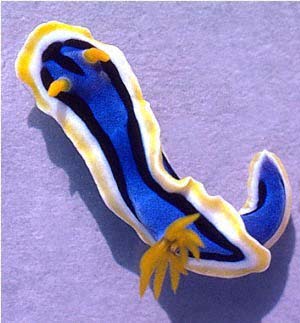
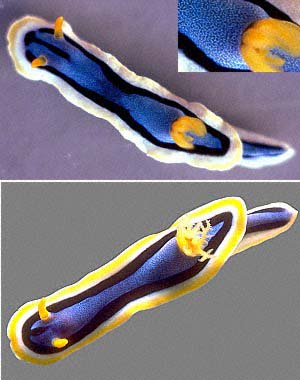
Chromodoris annae
Bergh, 1877
Order: NUDIBRANCHIA
Suborder: DORIDINA
Family: Chromodorididae
DISTRIBUTION
Tropical west Pacific and perhaps Indian Ocean.
PHOTO
UPPER: Buyong Beach, Mactan Is., Cebu, Philippines, 12-15m, April 1983. PHOTO: I.Loch.
CENTRE:Buyong Beach, Mactan Is., Cebu, Philippines, 10m, April 1983. PHOTO: I.Loch. Inset showing dark pitted surface in blue areas of mantle.
LOWER: Negros Island, Philippines, 20m, March 1983, PHOTO: B.E Picton.
This is another of the Chromodoris quadricolor colour group of species characterised by black longitudinal lines, bluish backgrounds and orange borders. This species has similarities to Chromodoris elisabethina but C. annae is characterised by the dark specks in the blue areas. The only other chromodorid with similar pitted blue regions is Chromodoris westraliensis. The animals illustrated here show the colour range within the species. The bottom animals matches best Bergh's original paintings. The orange border is just submarginal and in some specimens it is particularly faint.
Reference:
• Rudman, W.B. (1982c) The Chromodorididae (Opisthobranchia: Mollusca) of the Indo-West Pacific: Chromodoris quadricolor, C. lineolata and Hypselodoris nigrolineata colour groups. Zoological Journal of the Linnean Society 76: 183-241.
Rudman, W.B., 1998 (November 19) Chromodoris annae Bergh, 1877. [In] Sea Slug Forum. Australian Museum, Sydney. Available from http://www.seaslugforum.net/find/chroanna
Related messages
Chromodoris annae ? feeding on ascidians
January 14, 2010
From: Franca Wermuth
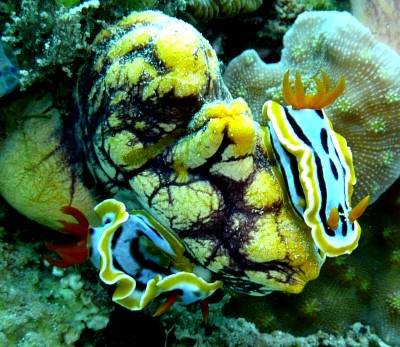
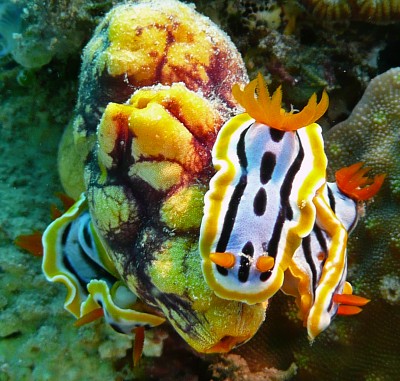
Concerning message #12079:
Are Chromodoris annae known to feed on sea squirts? It seems to me that these three nudibranchs are feasting on this Golden Sea Squirt.
I was also impressed by how good they were camouflaged with their yellow and blue on that sea squirt with the same colors.
Locality: Romblon, Cabanbanan Beach, 12, Philippines, Sibuyan sea, 30 September 2009. Photographer: Franca Wermuth.
Kind regards
Franca
franca.wermuth@gmx.ch
Franca Wermuth, 2010 (Jan 14) Chromodoris annae ? feeding on ascidians. [Message in] Sea Slug Forum. Australian Museum, Sydney. Available from http://www.seaslugforum.net/find/23081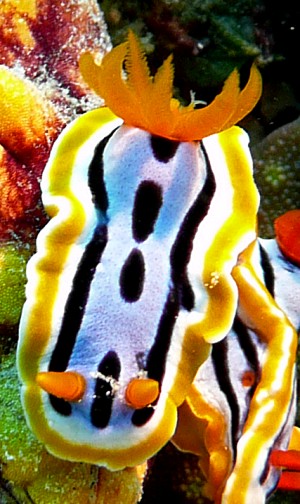
Dear Franca,
Thanks for this curious observation. All I can say is that as with Robert Sozzani's earlier message, which you refer to, chromodorids are not known to feed on ascidians. Of course if you find one actually biting into one then we will need to think again. Why they are aggregated on this sea squirt I have no idea. Certainly all the existing evidence shows that they are very specific feeders on particular sponges.
Your animals also raise an identification problem which you first drew my attention to a couple of years ago [see message #20173]. At that time I suggested your animals were possibly a colour form of C. magnifica - but I must admit my reasons don't sound that convincing on re-reading. There is also the possibility that they are C. michaeli. I am not convinced they are C. annae but I can't really offer a better alternative. I think we need to do more work on this group of species - including of course C. westraliensis.
Best wishes,
Bill Rudman
Chromodoris annae found sthn Queensland
December 21, 2009
From: Gary Cobb
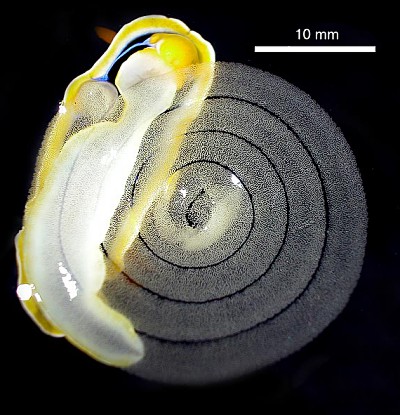
Concerning message #22807:
Hi Bill and everyone!
Finding a beautiful species is always a treat for us at Nudibranch.com.au. A tropical species we don't see often but have seen about a dozen times is Chromodoris annae. The first time we found it was at Old Woman Island in February 2004. According to Richard Willan it was a new record for southern Queensland.
Last weekend we dived Shellacey Reef off Mooloolaba Queensland and found 2 animals posed ready for a photo session. We collected the animals to see if it would lay eggs and it did! Photo attached. The egg mass is 28 mm in diameter and only 1.5 mm thick.
Locality: Inner Gneerings, Mooloolaba , 15 m, Queensland Australia, Pacific Ocean, 13 December 2009, Subtidal. Length: 55-90 mm. Photographer: Gary Cobb.
It is always good to get photos of egg masses, I hope these photos are valuable for the Forum.
Cheers
Gary
gary@nudibranch.com.au
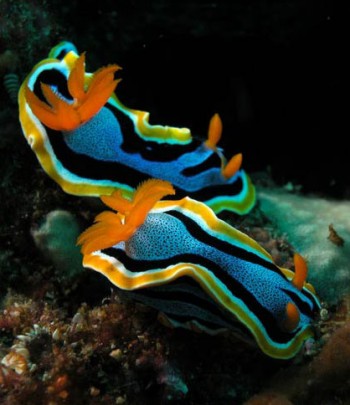
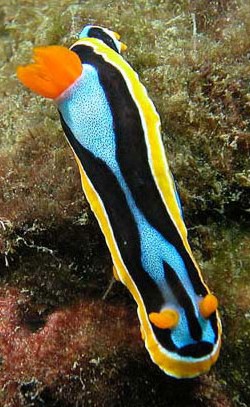
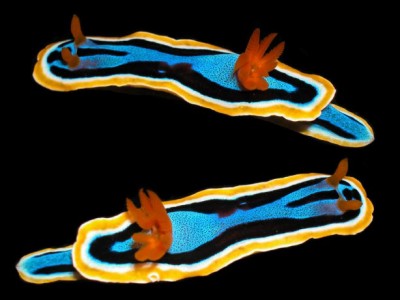
Dear Gary,
Thanks for the great photo of the egg ribbon. Chromodoris annae is one of the the similarly coloured 'C. quadricolor colour-group' of species which have this very characteristic 'flat' egg ribbon [See flat-egg Fact Sheet]. We haven't got a photo of this species' egg ribbon so it is a nice addition to the Forum
Best wishes,
Bill Rudman
Chromodoris annae, C. dianae & C. willani on one sponge
November 18, 2009
From: Mirjam Broos
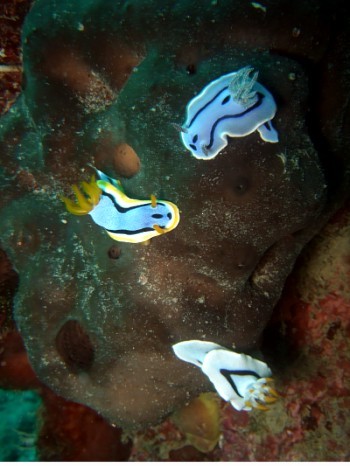
Hello Bill,
Just thought it would be nice to share these pictures of Chromodoris willani [upper], C. annae [middle] and C. dianae [lower] together on one sponge.
Locality: Mabul, Seaventure, Sabah, Malaysia, 24 september 2009. Photographer: Geert Prast.
Greetings,
Mirjam
mirjam.broos@planet.nl
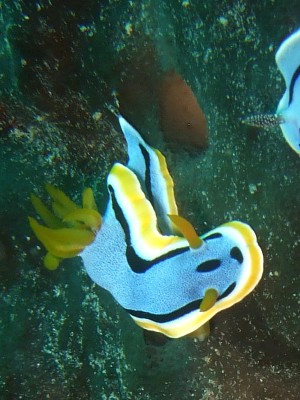
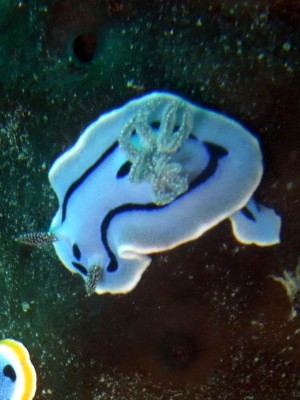
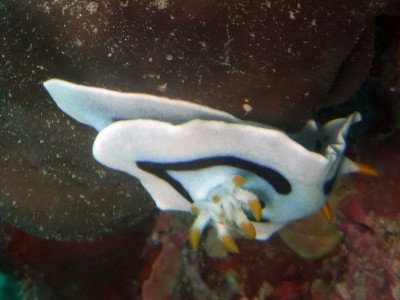
Dear Mirjam,
This is a very valuable photo as it is another example of similarly coloured species aggregating together on the same sponge which they are almost certainly feeding on. It is a thorectid sponge of the genus Petrosaspongia.
Interestingly, many of the black-lined chromodorids in the Pacific feed on this group of sponges, and the chromodorids are quite often found in multispecies groupings like this. As they all store distasteful chemicals from their prey sponges in their mantles, I suspect that fish have learned to avoid black-lined slugs - a case of safety in numbers.
Best wishes,
Bill Rudman
Chromodoris annae feeding, white sponge - Philippines
January 19, 2009
From: Marcel Tanke
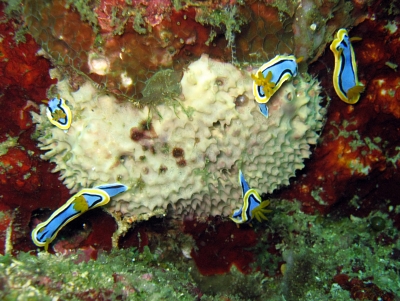
Concerning message #14928:
Dear Bill,
Five Chromodoris annae on- and around a white sponge. Although, also the red sponge in the background seems to have their interest.
Locality: Anilao, 15 meter, Philippines, 30 December 2008. Length: max 5 cm. Photographer: Marcel Tanke.
Best regards,
Marcel
marceltanke@cs.com
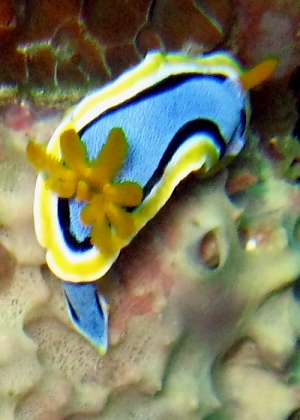
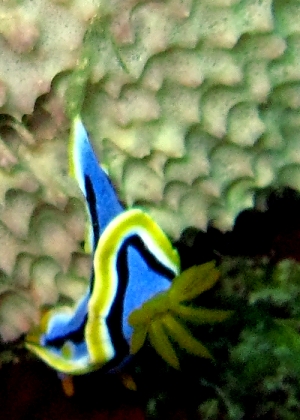
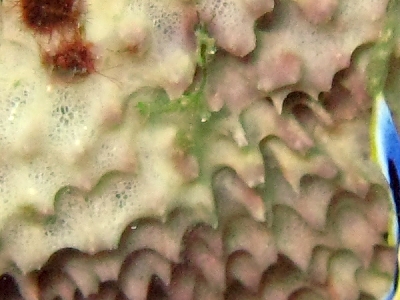
Dear Marcel,
This is a nice find. There are not many white sponges and this reminds me of a species of thorectid sponge that Glossodoris sp. 14 has been found on [message #9600]. If so, it will be a further confirmation that C. annae, like other similarly coloured species of Chromodoris, feeds on thorectid sponges. I will need to get the sponge identified.
Best wishes,
Bill Rudman
Chromodoris annae with 2 separate mantles
July 17, 2008
From: Marcel A. Tanke
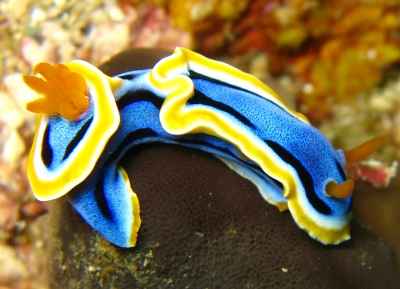
Dear Bill,
We found this interesting Chromodoris annae feeding on a brown sponge. Its mantle is split into 2 full rings. So I suppose it is a developmental abnormality.
Locality: Anilao, 10-15 meters, Philippines, 13 July 2008. Length: 4 cm. Photographer: Marcel Tanke.
Regards,
Marcel
marceltanke@cs.com
Tanke, M.A., 2008 (Jul 17) Chromodoris annae with 2 separate mantles. [Message in] Sea Slug Forum. Australian Museum, Sydney. Available from http://www.seaslugforum.net/find/21706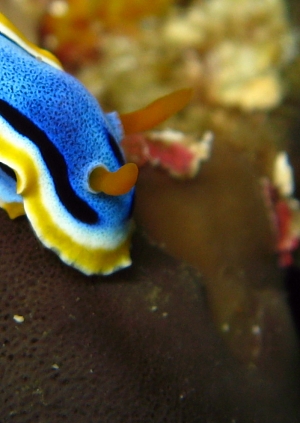
Thanks Marcel,
It is an interesting find, and I would agree that it a developmental abnormality. It is also nice to get a third record of this species feeding on this sponge, which is almost certainly a species of Petrosaspongia.
Best wishes,
Bill Rudman
Multi-lined C. annae from Vietnam
September 11, 2006
From: Mike Krampf
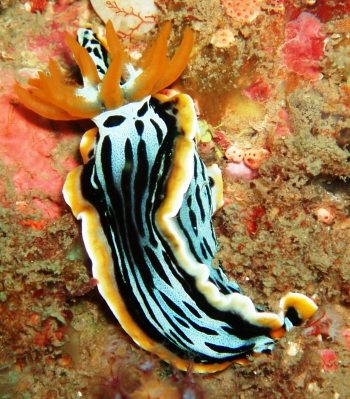
I apologize if I've already sent you this one. I was looking through my pics from Vietnam and haven't been able to ID this nudi. Your thoughts?
Locality: Three Kings dive site off Whale Island, 50 Ft, North of Nha Trang, Vietnam, South China Sea, 28 June 2006, Rock Pinnacle. Length: 4 cm. Photographer: Mike Krampf.
Thanks as always,
Mike
mtkrampf@yahoo.com
Krampf, M., 2006 (Sep 11) Multi-lined C. annae from Vietnam. [Message in] Sea Slug Forum. Australian Museum, Sydney. Available from http://www.seaslugforum.net/find/17497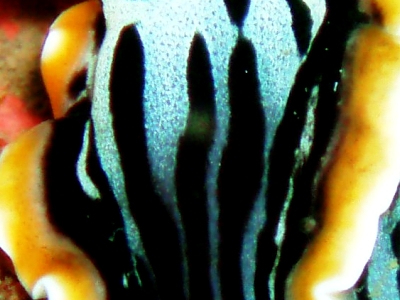
Dear Mike,
I am beginning to wonder if the South China Sea region is one of those geographic regions which have a particular colour pattern, likre the red-spotted chromodorids in south-eastern Australia and the 'blue chromodorids' of the Mediterranean. In the South China Sea there seem to be quite few species with multiple black lines. Some of these I have considered in the past to be a variety of Chromodoris magnifica [see message #6907], while this one is something else. I think the clue to its identity is the punctate colour pattern on the mantle - that is the scattering of small darker pits all over the blue region. A number of similarly coloured species have this punctate pattern including C. annae, C. michaeli and C. westraliensis. I am beginnng to wonder if they are all colour variants of one species. Certainly C. westraliensis could be comfortably considered a West Australian variant of C. annae. I think at this stage I will consider your animal to be a variant of C. annae. While I am travelling, perhaps you could see if you have other photos which might linke this animal with these other species. For example see messages #316, #8535, #4662.
Best wishes,
Bill Rudman
Is this Chromodoris magnifica?
March 3, 2006
From: Asther M. Lau
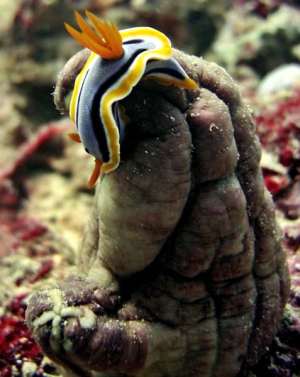
Hello Bill!
Found this nudi perching on what seem like a sponge coral or ascidian. Not sure if the nudi is eating it or not because when I found it, it was very still... hardly any movement. Maybe sleeping?
Locality: Mabul Is., 16 metres, Sabah, Malaysia, Celebes Sea, 15 March 2004, Underneath an abandoned oil rig. Scattered rocks & sponges. Muck diving.. Length: 4 cm. Photographer: Asther M. Lau.
Please help me confirm is this is a color variation of Chromodoris magnifica.
Really appreciate it!
Thanx!
Asther
asther@astherlau.com
Lau, A, 2006 (Mar 3) Is this Chromodoris magnifica?. [Message in] Sea Slug Forum. Australian Museum, Sydney. Available from http://www.seaslugforum.net/find/16006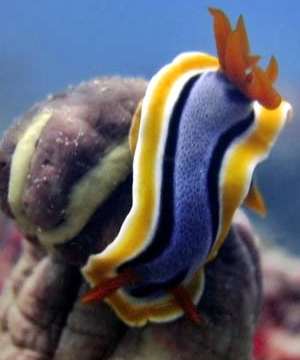
Dear Asther,
This is Chromodoris annae. If you look carefully at the blue part of the volour pattern you will see it is not a uniform colour but has many darker blue specks - which we call a punctate pattern. This is one obvious way that C. annae differs from the very similarly coloured species C. elisabethina. The animal in your photo.is sitting on a large solitary sea squirt.
Unless it is being very adventurous, I sure it won't be eating it. Chromodorids are very specialised sponge feeders.
Best wishes,
Bill Rudman
Chromodoris annae feeding - SE Sulawesi
October 6, 2005
From: Lindsay Warren
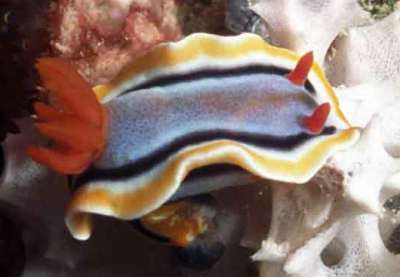
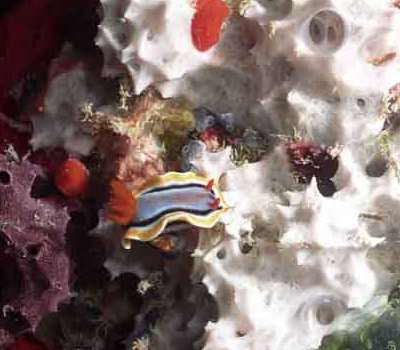
Dear Bill
Following the other two feeding examples I sent recently, here is another which might be of interest. This one is of a Chromodoris annae tucking into a white sponge which was quite firm but elastic to the touch. The C. annae did not want to budge. Unfortunately I couldn't get in that close to get a good clear close-up as it was tucked away upside down under an overhang.
Locality: Pulau Hoga, Tukang Besi Archipelago, SE Sulawesi, Indonesia
Banda Sea. Depth: 49 ft. Length: 25 mm. 4 November 1999. Steep drop-off with many nooks & crannies, overhangs, teaming with benthic life. Photographer: Lindsay Warren
Other than the sponge, another interesting thing about this C. annae is the orange caste to the blue punctate notum which we noticed on other C. annae in the area. Similar to the one found when Bernard Picton was on Pulau Hoga in 1997 which you have posted on the Forum.
Incidentally, it is interesting to know the origin of 'fundi' [message #14894]- just an expression I picked up on trips to South Africa! Perhaps your sponge 'fundi' will know which sponge this C. annae is feeding on.
All the best as ever
Lindsay
LWarren@datonomy.co.uk
Warren, L.C.R., 2005 (Oct 6) Chromodoris annae feeding - SE Sulawesi. [Message in] Sea Slug Forum. Australian Museum, Sydney. Available from http://www.seaslugforum.net/find/14928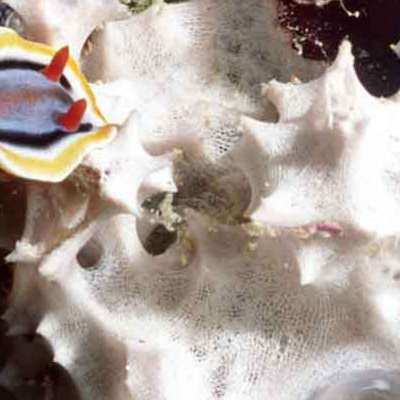
Dear Lindsay,
Another interesting observation. It looks like a species of Darwinella, but I will check it out. Hopefully in a couple of months I will be able to post all the identifications on the Forum.
Best wishes,
Bill Rudman
Chromodoris annae feeding on ascidians
February 18, 2004
From: Roberto Sozzani
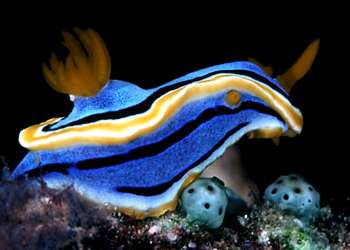
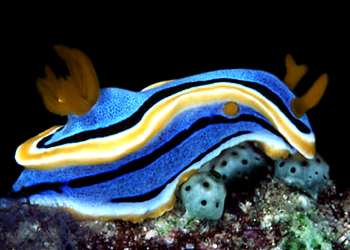
Dear Bill,
I found these two photos in which a Chromodoris annae seems really interested in some ascidians (Didemnum molle). I hope this can be of interest to you.
Manado - Indonesia, December 2003, about 20 meters.
PS: This animal has a bifid rhinophore.
Best regards
Roberto Sozzani
roberto.sozzani@fastwebnet.it
Sozzani, R., 2004 (Feb 18) Chromodoris annae feeding on ascidians. [Message in] Sea Slug Forum. Australian Museum, Sydney. Available from http://www.seaslugforum.net/find/12079Dear Robert,
This animal seems to be really interested in the ascidians, but unless we can actually see them everting their mouthparts we can't say much. We know that chromodorids are all sponge feeders so its most unlikely they would feed on ascidians. That is not to say we should believe everything we read, because that would prevent us discovering anything new. However on the whole I think this animal is just 'rearing up', as they often do, to sense the environment with its rhinophores.
Best wishes
Bill Rudman
Chromodoris annae on sponge
January 29, 2004
From: Roberto Sozzani
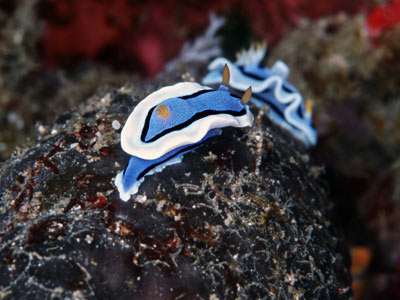
Dear Bill,
I found another photo of Chromodoris annae on sponge from Manado (Indonesia), shot in November 2003.
This time, a C. dianae is in the background sharing the same sponge.
Best regards
Roberto Sozzani
roberto.sozzani@fastwebnet.it
Sozzani, R., 2004 (Jan 29) Chromodoris annae on sponge. [Message in] Sea Slug Forum. Australian Museum, Sydney. Available from http://www.seaslugforum.net/find/12040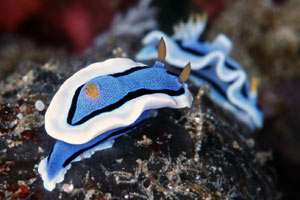
Thanks Roberto,
From this photo I am pretty sure the unidentified animal in your earlier message is C. annae. I also suspect this sponge is the same species as the one in that message. It is interesting how C. annae and C. elisabethina on these dark grey black sponges have very dull orange pigmentation - in fact they lack the orange pigmentation. It certainly makes them better mimics of the species without an orange border. Perhaps the pigment they require is not available in this group of sponges. We are not sure whether essential pigments are obtained from their food but it is an interesting hypothesis
Best wishes
Bill Rudman
Chromodoris annae on sponge
January 29, 2004
From: Roberto Sozzani
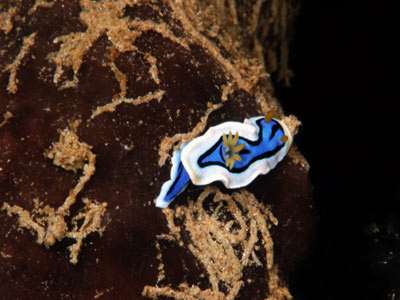
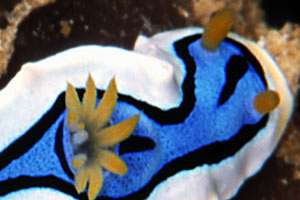
Dear Bill,
I found also this Chromodoris annae in my Manado (Indonesia) photos, shot on June 2003. This time the sponge seems different from the previous ones, preferred by C. dianae and C. willani.
Depth should be about 15 meters.
Best regards
Roberto Sozzani
roberto.sozzani@fastwebnet.it
Sozzani, R., 2004 (Jan 29) Chromodoris annae on sponge. [Message in] Sea Slug Forum. Australian Museum, Sydney. Available from http://www.seaslugforum.net/find/12038Thanks Roberto,
The close-up of the mantle clearly shows the blue punctate pattern typical of Chromodoris annae. Unfortunately there is not enough information about the sponge. Would you by chance have a photo showing more of the sponge colony? It might give us more clues to its identity.
Best wishes
Bill Rudman
Chromodoris annae from Malaysia
January 26, 2004
From: Fredy Brauchli
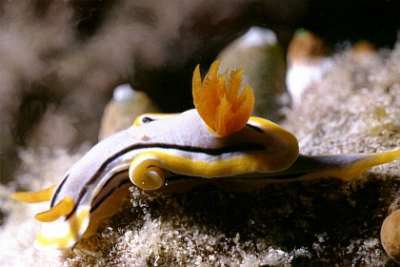
Dear Bill,
I found another astonishing and confusing picture. It looks like Chromodoris annae, but instead of the characteristic blue you can only see e light greyish colour on top. This animal has another very special character: a kind of deformed mantle.
The image was taken in Sipadan, Malaysia, in July 1997. Can you identify this nudibranch?
Best wishes,
Fredy
brauchli@subaqua.ch
Brauchli, F., 2004 (Jan 26) Chromodoris annae from Malaysia. [Message in] Sea Slug Forum. Australian Museum, Sydney. Available from http://www.seaslugforum.net/find/11970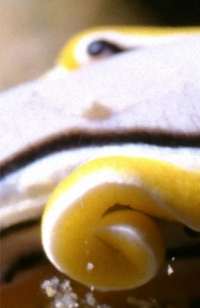
Dear Fredy,
I think it is C. annae. The blue can very in intensity in this species. It seems the damage to the mantle occurs on both sides so it seems it may be a result of some mistake during its development, rather than physical damage caused since its reached adulthood.
Best wishes
Bill Rudman
Abnormal Chromodoris annae
June 12, 2003
From: Paul Whitehead
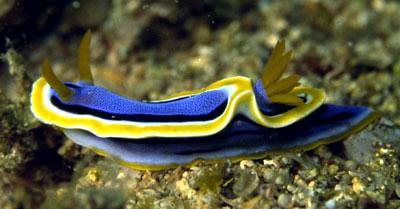
Dear Bill,
I believe that this nudibranch may be Chromodoris annae but it seems to have a have developed a oddity on its back - what do you think?
Photograph was taken in Puerta Gallera, Philippines in May 2003 at 20-25 meters (site: The Boulders)
Paul Whitehead
whitehead@damnam.org
Whitehead, P., 2003 (Jun 12) Abnormal Chromodoris annae. [Message in] Sea Slug Forum. Australian Museum, Sydney. Available from http://www.seaslugforum.net/find/10202Dear Paul,
I agree with your identification, and yes it has a definite oddity on its mantle. An early nudibranch expert, Charles Eliot, once describd a new genus for a specimen of the related genus Hypselodoris which he found with the gill opening in the posterior midline below the mantle edge. This is a very similar sort of abnormality.
Best wishes,
Bill Rudman
Chromodoris annae from Malaysia
May 16, 2003
From: Harro Quitzau
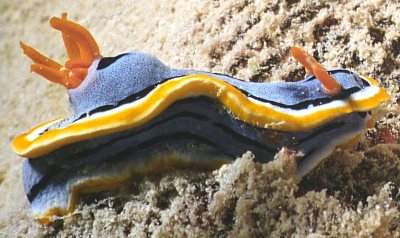
Hello,
I have problems to identifying this one. It seems to be a Chromodoris.
Location: Mabul, Malaysia
Date: March 14, 2003
Site: "Seaventure"
Depth: 18m
Best regards,
Harro
Harro@Quitzau.info
Quitzau, H., 2003 (May 16) Chromodoris annae from Malaysia. [Message in] Sea Slug Forum. Australian Museum, Sydney. Available from http://www.seaslugforum.net/find/9661Dear Harro,
This is Chromodoris annae.
Cheers,
Bill Rudman
Chromodoris annae with trifurcated rhinophore
December 10, 2002
From: Mary Jane Adams
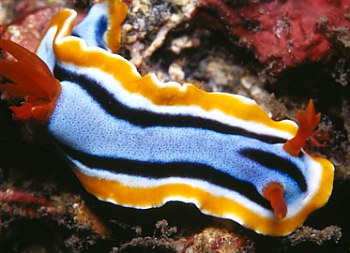
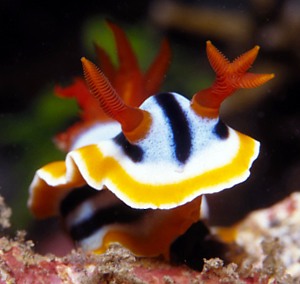
Hi Bill,
Here is another one for your deformity page. At first glance this Chromodoris annae looked normal. However, when I focused in on the rhinophores I saw that the left one was trifurcated. I wonder if the
additional surface area increases it's ability to detect food or if the three branches pointing in different directions relay confusing signals. It would also be interesting to know if this anomaly is a
dominant or recessive trait.
Lembeh Strait, Sulawesi, Indonesia, Nov. 26, 2002. Divesite: Magic Crack
Crawling length: about 3cm.
Depth: about 15 meters
Best regards,
Mary Jane
divepng@yahoo.com
Adams MJ., 2002 (Dec 10) Chromodoris annae with trifurcated rhinophore. [Message in] Sea Slug Forum. Australian Museum, Sydney. Available from http://www.seaslugforum.net/find/8593Thanks Mary Jane,
Bill Rudman
Chromodoris annae from North Sulawesi
October 6, 2002
From: Marli Wakeling
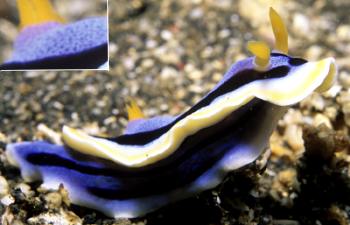
Hi Bill,
Here is what I think is Chromodoris annae, from another site at Lembeh Strait, Suluwesi.
Location: Nudi retreat, Lembeh Strait, North Suluwesi, Indonesia.
Date: July, 2002
Depth: 45 feet
Length: 3 cm.
Photograph: Marli Wakeling
Regards,
Marli
scubamarli@excite.com
Wakeling, M., 2002 (Oct 6) Chromodoris annae from North Sulawesi. [Message in] Sea Slug Forum. Australian Museum, Sydney. Available from http://www.seaslugforum.net/find/8097Thanks Marli,
Yes the darker marks on the blue, confirm this is C. annae.
Best wishes,
Bill Rudman
Mating of different species
October 1, 2002
From: Gillian Elliott
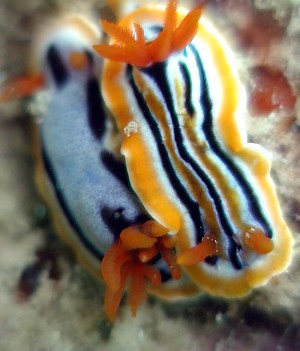
Dear Bill
I work as a biologist on Mantanani Island in the South China Sea off the coast of Sabah, Malaysian Borneo.
Recently I spotted a pair of sea slugs mating that were of different species of Chromodoris. Has this ever been recorded before? How could it happen...faulty chemoreception systems? Attached is the picture of this event - seen at 10m depth at
1600hrs.
I look forward to hearing from you
Gillian Elliott
gillyelliott@yahoo.com
Elliott, G. , 2002 (Oct 1) Mating of different species. [Message in] Sea Slug Forum. Australian Museum, Sydney. Available from http://www.seaslugforum.net/find/7664Thanks Gillian,
From the position of these two animals I don't think they are mating. Although during mating their right sides need to be together, as their genital openings are just behind the rhinophores, their heads would need to be much closer together for mating to be physically possible. I suspect in this case that the upper one [on the right] is just crawling past. The question of interspecific mating is quite interesting but can lead to rather circular discussions. One way we tend to define a 'species' is to see what it will mate with. In the chromodorids there are problem groups which are either a group of very similarly coloured but distinct species, or one species with a number of distinct colour morphs. I tend to think that if you find two colour 'morphs' mating, then that is an indication that they are a single species. However I guess it could be argued that it is evidence of inter-specific mating behaviour. In the Forum, I tried to raise this very question but no one wants to discuss it. I posted a photo of two colour 'forms' of Hypselodoris bullocki mating. One was a fairly 'typical' colour, and the other has recently been described as a distinct species.
Concerning the identity of your two animal. The lower animal is Chromodoris annae and the upper one [on right] is a species or 'colour form' which I am calling Chromodoris cf. colemani, not because I think it is that species, but because it looks quite like it.
Best wishes,
Bill Rudman
Re: Chromodoris magnifica vs. C. annae
August 1, 2002
From: Erwin Köhler
Dear Bill,
Re your comment - Like many other uw-photographers am I working with a digital camera. There is no possibility of influence on a film ... I always use 1/250 sec. and the smallest diaphragm, correcting the exposures with the power of my flashgun. Bernard Picton sent to you some similar looking shots at March 13, 2002 - which you IDed also as possible Chromodoris annae.
Cheers,
Erwin
Erwin@medslugs
Köhler, E., 2002 (Aug 1) Re: Chromodoris magnifica vs. C. annae. [Message in] Sea Slug Forum. Australian Museum, Sydney. Available from http://www.seaslugforum.net/find/7680Dear Erwin,
I was going to mention variation in digital cameras as well but didn't want to overemphasise the point that whatever system we use to record an animal's colour, there is no such thing as a perfect or 'absolute' method. I recently, as a test, photographed a colouful shell with two digital cameras and two flatbed scanners. All produced rather different results - and one of the scanners produced the most accurate results, although I admit that using a flatbed scanner for nudibranchs, either above or in the water, wouldn't be very practical!
I am quite happy to accept your photo is an accurate colour record of the animal you saw, as it is quite clear that many of these species do show colour variability. That is why I suggested it is usually more important to look at the total colour pattern and combination of colours rather than think that a light orange gill means one species, and a reddish gill means a different species. Interestingly Chromodoris magnifica shows a similar variation in the gill and rhinophore colour, some being almost red, other light orange. In this case, I think the spotted pattern on the blue is pretty convincing evidence that your animal is a colour form of C. annae.
Cheers,
Bill Rudman
Chromodoris magnifica vs. C. annae
July 31, 2002
From: Erwin Köhler
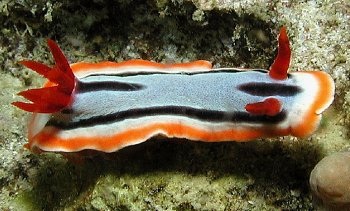
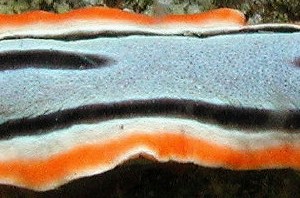
Dear Bill,
Attached is a shot from the Philippines, Malapascua Island, divesite Lighthouse.
It has the typical spots of Chromodoris annae but the general colour of Chromodoris magnifica.
Or is it something else?
Data: size 41mm
Depth: 6m
Date: 24 February 2002
Erwin
erwin@medslugs.de
Köhler, E., 2002 (Jul 31) Chromodoris magnifica vs. C. annae. [Message in] Sea Slug Forum. Australian Museum, Sydney. Available from http://www.seaslugforum.net/find/7656Dear Erwin,
This is C. annae. The orange colours do seem a bit redder and more intense than normal but darker variations do occur. Another possibility, which I am sure you have thought of, is that the colour make have been affected by photo technology. When I see unusual colours in a photo my first thought is that film exposure, brand, (Agfa, Fuji, Kodak etc) and processing can all influence the final colours. That's why its always helpful if we have a combination of colours to define a species. In this case the dark spots on the blue, the submarginal, rather than marginal, orange border, and the usually broken median black line.
Cheers,
Bill Rudman
Re: Chromodoris annae - Strange discovery
May 15, 2002
From: Jun Imamoto
Dear Bill.
Thanks for your comments. But, it doesn't seem to me that the digital camera makes such a mistake. I have taken several thousand photos of sea slugs until now with the same digital camera but until now this has never occurred. Of course this could be the first time. What I can do from now is to try again with Chromodoris annae. Next time, it will try to observe it carefully and take continue to take some pictures if a change in the color is seen.
Thank you very much.
Best Regards,
Jun Imamoto
imamoto@wips.co.jp
Imamoto, J., 2002 (May 15) Re: Chromodoris annae - Strange discovery. [Message in] Sea Slug Forum. Australian Museum, Sydney. Available from http://www.seaslugforum.net/find/6926Dear Jun,
I will be interested to see what happens
Best wishes,
Bill Rudman
Re: Chromodoris annae - Strange discovery
May 7, 2002
From: Brian K. Penney
Bill-
I agree with your suggestion that the digital camera memory being overloaded, etc. is the most likely possibility. However, there is a paper that describes the blue pigments of Hypselodoris zebra [as Chromodoris zebra] changing color based on local redox potential. These experiments were in a test tube, not the animal, but the author claims that nudibranch blood pH creates an appropriate environment for such a reversible reaction. See:
• Preisler, P. W. 1930. Oxidation-reduction potentials and the possible respiratory significance of the pigment of the nudibranch Chromodoris zebra. Journal of General Physiology, 13: 349-359.
Cheers!
Brian
bpenney@ualberta.ca
Penney, B.K., 2002 (May 7) Re: Chromodoris annae - Strange discovery. [Message in] Sea Slug Forum. Australian Museum, Sydney. Available from http://www.seaslugforum.net/find/6890Thanks Brian,
Bill Rudman
Chromodoris annae - Strange discovery
May 3, 2002
From: Jun Imamoto
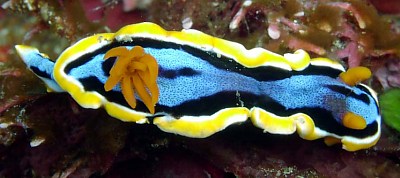
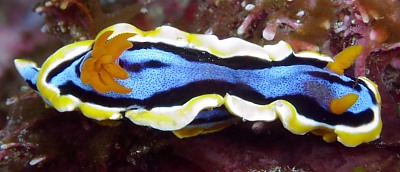
Dear Bill.
I was watching the continuous photograph of Chromodoris annae, and I had strange discovery.
If you compare the two photographs, a part of the color of mantle changes white in a moment. It is the part of the yellow ribbon of the outside side.
The time interval between these photographs is only eight seconds.
m6779a.jpg : 10:49:52
m6779b.jpg : 10:50:00
(From the data on the digital camera.)
Date: 3 Mar 2002
Place: Hachijo Island, Japan
Depth: 8m (Intertidal)
Size: about 30mm
Water temperature: 19C degrees.
Best Regards,
Jun Imamoto
imamoto@wips.co.jp
Imamoto, J., 2002 (May 3) Chromodoris annae - Strange discovery. [Message in] Sea Slug Forum. Australian Museum, Sydney. Available from http://www.seaslugforum.net/find/6779Dear Jun,
Thanks for these interesting photos. Did you take further photos of the animal? If so, did the border stay white or become yellow again. As far as I understand, the pigments in the skin of a chromodorid are pigments incorporated into the skin tissue and so should not be capable of a quick change like this. My feeling is that it is something to do with the digital camera. Perhaps its memory was a bit overloaded when you were taking a sequence of photos and couldn't quite carry all the information it needed to accurately record the second photo - much like a computer sometimes doesn't display icons correctly when its 'thinking' too hard.
I may be quite wrong but I don't think it is the slug
Best wishes,
Bill Rudman
Chromodoris annae from the Solomons
April 16, 2002
From: Bruce Potter
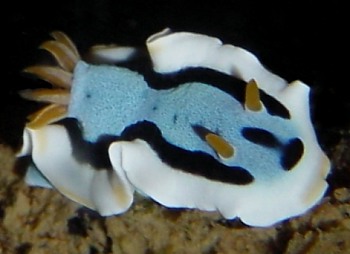
Dear Bill,
I dived at Tulagi in the Florida Group of the Solomon Islands, yesterday [March 2002]. I found several of these nudi's together, and thought at first that they were Chromodoris annae which I see here quite frequently. Then I noticed that there was almost no yellow margin around the skirt, and wondered if perhaps they might be Chromodoris dianae
They were about 3 to 4 cm long. They were on a dead coral and rubbish site, at about 12 meters. It was a night dive.
Regards
Bruce Potter.
bruce.potter@adventist.org.sb
Potter, B., 2002 (Apr 16) Chromodoris annae from the Solomons. [Message in] Sea Slug Forum. Australian Museum, Sydney. Available from http://www.seaslugforum.net/find/6654Thanks Bruce,
Although they have similarities to C. dianae, in that species the blue extends outside the black lines almost to the border. I think your first thought was correct. This appears to be a C. annae with a severe shortage of orange pigment.
Best wishes,
Bill Rudman
Colour variation in Chromodoris annae
March 13, 2002
From: Bernard Picton
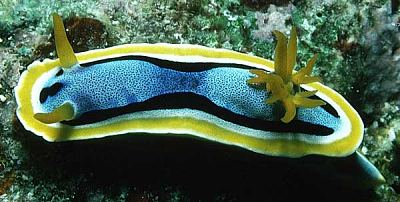
Hi Bill,
I've sent a couple of scans of Chromodoris annae to show variation in the black pigment along the midline. Normally this seems to be absent, but as you can see from the very pale specimen here it can be quite extensive as a broken line. I think both the animals sent by Lindsay on November 19, 1998 are C. annae. In fact I am fairly certain that I have never seen C. elisabethina in Indonesia. I wonder if it has a strange distribution pattern where it stops at Western Australia and Papua New Guinea?
Upper Right: - Hoga Is, Sulawesi, Indonesia. - October 1997
Lower Left: - Dumaguete, Negros, Philippines - 30 MAR 1983 - BEPPH75
Lower Right: - NW Bali, Indonesia - March 1996
Bernard
bernard.picton.um@nics.gov.uk
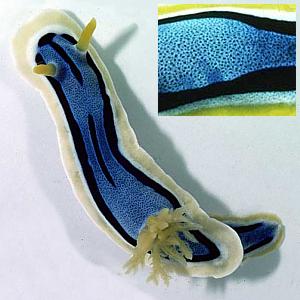
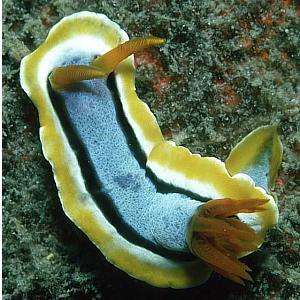
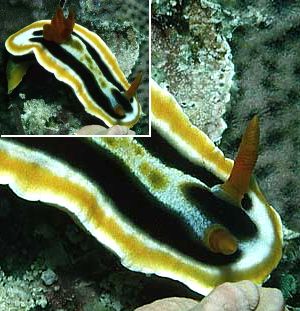
Thanks Bernard,
I think you are right about Lindsay's two animals, They are almost ceratinly C. annae.
In your message about Chromodoris magnifica one of the photos you suspect may not be C. magnifica is most probably C. annae. I have copied it alongside. The characteristic punctate blue pattern is clearly visible. If I have identified it correctly, it looks as though it can have a central row of pigment - in this case orange brown. It is from Hoga Is., Sulawesi, Indonesia. Oct 1997.
Best wishes,
Bill Rudman
Chromodoris annae from the Philippines
January 11, 2002
From: Erwin Köhler
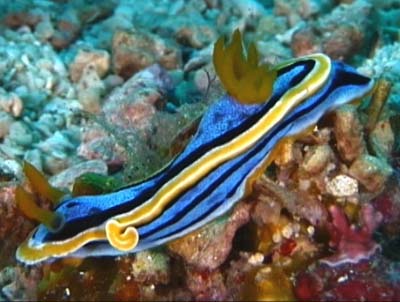
Dear Bill,
Here is a photo of Chromodoris annae from the Philippines by Peter Schmutz [peterschmutz@cs.com].
Other data were not recorded. What are the blue spots on it?
Erwin Köhler
Erwin@medslugs.de
Köhler, E., 2002 (Jan 11) Chromodoris annae from the Philippines. [Message in] Sea Slug Forum. Australian Museum, Sydney. Available from http://www.seaslugforum.net/find/4902Dear Erwin,
I don't recall seeing an animal with these darker blue patches you ask about. C. annae is one of a few species which has what I have described as a light blue background with many scattered darker blue spots. It is probably better described as being dark blue with scattered light blue spots, which look as though they could be white subepithelial glands. [see the closeup photo on the Species Fact Sheet]. In your animal it looks like the dark patches are the result of damage - perhaps something grazing or nibbling on the skin like a small fish or more likely, a copepod parasite.
Best wishes,
Bill Rudman.
Chromodoris annae, I believe
August 14, 2001
From: Ken Tucker
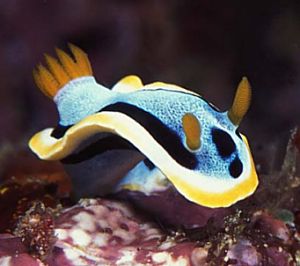
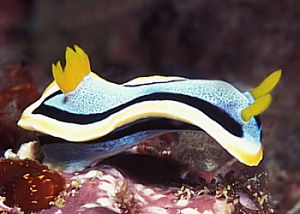
You have images from Indonesia & Western Australia. This one comes from the Solomons.
Taken 8 January 1997, and that's all the info I recorded.
Ken
Ken@kilili.com
Tucker, K., 2001 (Aug 14) Chromodoris annae, I believe. [Message in] Sea Slug Forum. Australian Museum, Sydney. Available from http://www.seaslugforum.net/find/5069Thanks Ken,
Bill Rudman
Is it Chromodoris michaeli?
June 29, 2001
From: Carrie
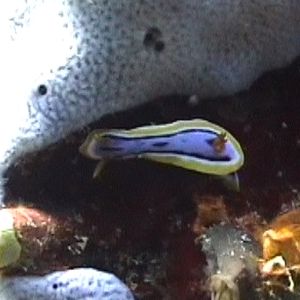
Dear Bill,
I am a nudibranch fanatic. Enclosed is a still pic captured fr my video shot. Is it Chromodoris annae or Chromodoris michaeli. It was found on 8th March 2001 at around 30 feet at dive site Great Wall, Mantanani Islands, north east of Kota Kinabalu, Sabah, Malaysia. Measures around 8cm long.
Carrie.
bubbleurchin@yahoo.com
Carrie, 2001 (Jun 29) Is it Chromodoris michaeli?. [Message in] Sea Slug Forum. Australian Museum, Sydney. Available from http://www.seaslugforum.net/find/4684Dear Carrie,
This is Chromodoris annae.
Best wishes,
Bill Rudman
Student in need of help
January 5, 2001
From: William Misa
Hi Bill,
Love your site..... its the bomb!!!!!=) Youre the answer to my term paper prayers. My name is William Misa.... Bill also. I live in Cebu city , Philippines. Im currently lost as to what topic i should focus my paper on. In this area that i live.... the species Chromodoris annae is of abundance..... if you could please help me out....point me in a direction. what can i study about these things. I know there are a lot of things to study about them, but id really appreciate a little nudge in the right direction... Thanks a whole lot.=)
Bill
Xavier721@yahoo.com
Misa, W., 2001 (Jan 5) Student in need of help. [Message in] Sea Slug Forum. Australian Museum, Sydney. Available from http://www.seaslugforum.net/find/3402Dear Bill,
I am not sure what you are able to do. Are you are going to be doing actual field research or just library work? If you are doing field work I would need to know how much time you have to spend and how quickly it needs to be done. It's no good me suggesting you look, for example, at their breeding cycle if your study has to be completed in a couple of months.
Working on the assumption you haven't much time, why don't you have a look at something that's possible. If Chromodoris annae is quite common, why don't you have a look at some fairly obvious things like what sponges does it eat, what does its egg ribbon look like, how much colour variation can you find, is there much difference in colour between juveniles and adults etc. It would also be useful to compare it with any similarly coloured species that occur in the same area such as Chromodoris elisabethina and perhaps Chromodoris magnifica. If that sounds interesting and feasible let me know and we can discuss it in more detail by email. Another interesting, but quite different, topic would be looking at feeding in Notodoris minor. If you have a look at the messages on that page you will see that Notodoris minor may digest its sponge food externally before swallowing it. It would certainly be an interesting topic to investigate.
Let me know what you think,
Best wishes,
Bill Rudman.
Chromodoris annae for sale in Brazil
April 21, 2000
From: Carlo Magenta-da-Cunha
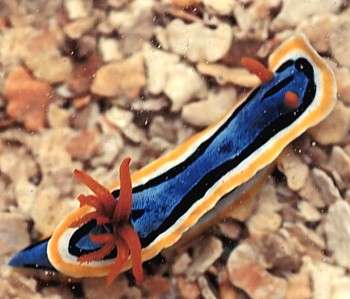
Dear friend,
This specimen of Chromodoris annae was seen for sale in an Aquarium Shop, for $US26. I'm sad to see this. I bought this animal and deposited it in MZUSP (Museum of São Paulo University).
Best regards,
Magenta
carlomagenta@uol.com.br
Magenta-da-Cunha, C., 2000 (Apr 21) Chromodoris annae for sale in Brazil. [Message in] Sea Slug Forum. Australian Museum, Sydney. Available from http://www.seaslugforum.net/find/2301Dear Magenta,
This is definitely a West Pacific species, so perhaps your Oxynoe and Caulerpa were also from the Pacific. I suppose there is a symmetry in people in Australia wanting to keep fish from the Amazon River in their aquaria and people from Brazil wanting to keep animals from Australian waters in their aquaria. Unfortunately, in both cases they could cause grave ecological damage if they released their imported 'prizes' into the environment.
best wishes,
Bill Rudman.
Chromodoris annae from Malaysia
March 11, 2000
From: Erwin Koehler
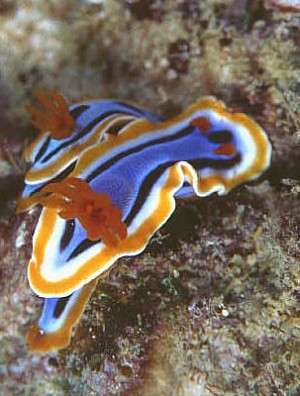
Hi Bill,
This one is by Giovanni Marola email: marola@iet.unipi.it - this picture has been taken at Lankayan Island, eastern Sabah (Malaysia), February 09, 2000 at a depth of about 15-20 meters.
There are so many similar looking species, can you identify it?
Erwin.
Medslugs.Koehler@t-online.de
Koehler, E., 2000 (Mar 11) Chromodoris annae from Malaysia. [Message in] Sea Slug Forum. Australian Museum, Sydney. Available from http://www.seaslugforum.net/find/2071Dear Erwin,
This is Chromodoris annae. Sorry there are so many similar looking species - I would prepare a page on the C. quadricolor - colour group if I there were 36 hours in the day.
C. annae is quite distinctive having darker specks or pits all over the blue area of the mantle.
Best wishes,
Bill Rudman.
My school project on Chromodoris annae
February 22, 2000
From: B. Friedman
Hello,
I am a 7th grade student and I am doing a project on the Sea Slug. I picked the Chromodoris annae. I have been having trouble finding information on it. I need to find out about its
Physical Charactoristics
Its connection to the food web
Social grouping
Environment
Health
It would be a big help if you could send me some general information or another website where I can get more information.
Thank you.
B. Friedman
Bessaroni@aol.com
Friedman, B., 2000 (Feb 22) My school project on Chromodoris annae. [Message in] Sea Slug Forum. Australian Museum, Sydney. Available from http://www.seaslugforum.net/find/1938Dear B. Friedman,
I am surprised you picked this species, which is found in the tropical western Pacific. We know very little about its biology and natural history other than it is almost certainly a specialist feeder on one or two species of sponge. I have put your message on the Chromodoris annae Page so look above and below you message for photos and messages we have on this species.
The family of nudibranchs it belongs to, the Chromodorididae, are very interesting because they have very toxic chemicals in their skin to defend themselves from fish attack. Their bright colours warn fish of their nasty taste. Have a look at the pages on Colour Patterns & Defence, defensive glands, Mimicry and go to the Species List and look at some of the species listed under the family Chromodorididae to get an idea of the variety of shape and colour amongst the relatives of Chromodoris annae.
Good luck with your project.
Bill Rudman.
Chromodoris annae from Vanuatu
November 24, 1999
From: Vinka Stenhouse
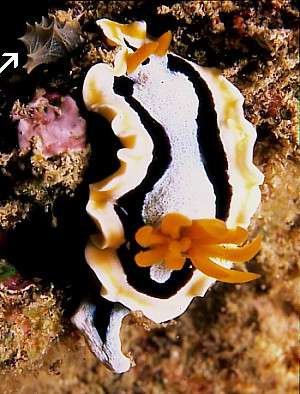
Dear Bill,
Here is another one from Espiritu Santo Is., Vanuatu, 1997. Is this Chromodoris annae? It was 30mm long, from 13 metres depth. PHOTO: J.K. Stenhouse.
Yours sincerely,
Vinka Stenhouse.
Santo.
Vanuatu.
Dear Vinka,
Yes this is C. annae. It differs from other similarly coloured species in having the punctate or pitted pattern in the blue region. Another species with this feature is Chromodoris westraliensis.
If you look in the top left corner of the photo, there seems to be a likely food sponge. It is possible that most of the colony is overgrown with algal turf.
Bill Rudman.
Rudman, W.B., 1999 (Nov 24). Comment on Chromodoris annae from Vanuatu by Vinka Stenhouse. [Message in] Sea Slug Forum. Australian Museum, Sydney. Available from http://www.seaslugforum.net/find/1577Chromodoris annae from W.Australia
April 27, 1999
From: Clay Bryce
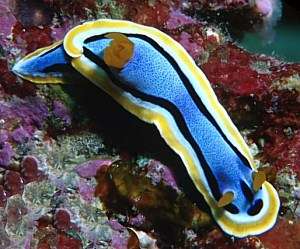
Dear Bill
Here is a photo of here C. annae from Hibernia Reef off the Kimberley coast in North Western Australia. It is very common on Hibernia Reef.
Clay Bryce
brycec@museum.wa.gov.au
Bryce, C., 1999 (Apr 27) Chromodoris annae from W.Australia. [Message in] Sea Slug Forum. Australian Museum, Sydney. Available from http://www.seaslugforum.net/find/806Thanks Clay,
Its good to get these records from Western Australia.
Bill Rudman.
Chromodoris annae? from Philippines
January 16, 1999
From: Erwin Koehler

Here is Chromodoris annae (Bergh, 1877), BBC, Panglao Is., Philippines, Nov. 1998.
Erwin
E.Koehler@deutschepost.de
Koehler, E., 1999 (Jan 16) Chromodoris annae? from Philippines. [Message in] Sea Slug Forum. Australian Museum, Sydney. Available from http://www.seaslugforum.net/find/476Erwin,
The best way to separate Chromodoris annae externally from Chromodoris elisabethina is the punctate blue pattern on the mantle. I can't really be sure in this photo and the black median line is intermediate between the short line between the rhinophores normally found in C. annae and the long, often entire, line found in C. elisabethina. Another feature which seems characteristic of C. annae is the distinctive thin white band at the mantle edge, which is visible in your photo.
Bill Rudman.
Another Chromodoris annae from Sulawesi
December 19, 1998
From: Lindsay Warren
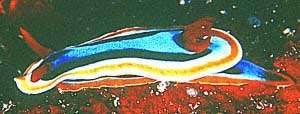
Subject: More Chromodorids from the Tukang Besi, Sulawesi, Indonesia.
Dear Bill
Here is the last of the backlog from earlier this year. It is probably Ch. annae as black specks noted on blue notum. Also black line between rhinophores and black patch at anterior edge of gill pocket. Rhinophores and gills deep orange. Length: 3cm. Found at depth of 16m on rubble on a steep slope. Photo: Adam Powell.
Thanks,
Lindsay Warren
100014.2112@compuserve.com
Warren, L., 1998 (Dec 19) Another Chromodoris annae from Sulawesi. [Message in] Sea Slug Forum. Australian Museum, Sydney. Available from http://www.seaslugforum.net/find/409Yes Lindsay,
It looks like C. annae although something seems to have happened in the photographic process to make the colours a bit abnormally harsh. The extra information about each species is very welcome.
Bill Rudman.
Chr. annae juvenile? from SE Sulawesi
November 29, 1998
From: Lindsay Warren
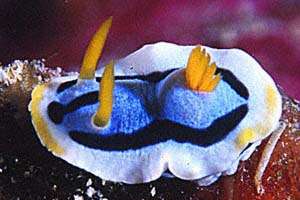
Dear Bill
Here is another chromodorid from Operation Wallacea on Pulau Hoga in the Tukang Besi Islands off SE Sulawesi, Indonesia.
The orange band around the mantle was broken and quite pale. Length: 1.5 cm
Thanks,
Lindsay Warren
100014.2112@compuserve.com
Warren, L., 1998 (Nov 29) Chr. annae juvenile? from SE Sulawesi. [Message in] Sea Slug Forum. Australian Museum, Sydney. Available from http://www.seaslugforum.net/find/342Dear Lindsay,
It would be useful if you could indicate the size of the animals. Sometimes juveniles have differences in colour and in proportions to adults. I suspect this animal is a juvenile Chromodoris annae, As you will see in the middle picture at the top of the page, the orange border can sometimes be faint or absent along the sides of the body. .. Bill Rudman.
Chromodoris annae from Sulawesi
November 19, 1998
From: Lindsay Warren
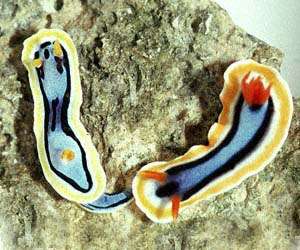
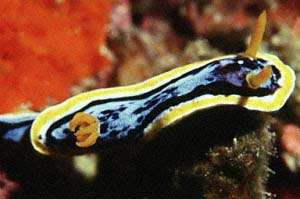
Dear Bill
Have just returned from three months once again working with Operation Wallacea on Pulau Hoga in the Tukang Besi Islands off SE Sulawesi, Indonesia.
Could you help us identify this photo? The left one probably a Chromodoris elisabethina and the right one possibly a Ch. annae. The second photo is of another Chromodorid with the 'grainy' blue of a C. annae but with additional black markings along the dorsum.
We have found many specimens with varying colour patterns which seem related to either Ch. annae or C. elisabethina and I will forward these to you as soon as they have been scanned in.
Many thanks for your help,
Lindsay Warren
75 Netherwood Road,
London W14 0BP
100014.2112@compuserve.com
Warren, L., 1998 (Nov 19) Chromodoris annae from Sulawesi. [Message in] Sea Slug Forum. Australian Museum, Sydney. Available from http://www.seaslugforum.net/find/316Dear Lindsay,
I think you are correct in identifying the animals in the top photo,, although the left one does suggest a punctate blue pattern. The punctate blue pattern is very characteristic of C. annae. I am less sure of the second photo, but your mention of a similar punctate blue pattern would tend to tip the scales towards C. annae. As more material appears from Indonesia and the Philippines the clear distinction in colour pattern between Ch. annae and C. elisabethina is starting to blur. It is certainly starting to look a bit like one of the colour forms of Chromodoris westraliensis.
Best wishes,
Bill
Chromodoris elisabethina from Sulawesi
November 19, 1998
From: Lindsay Warren

Dear Bill
Have just returned from three months once again working with Operation Wallacea on Pulau Hoga in the Tukang Besi Islands off SE Sulawesi, Indonesia.
Could you help us identify this photo? The left one probably a Chromodoris elisabethina and the right one possibly a Ch. annae.
We have found many specimens with varying colour patterns which seem related to either Ch. annae or C. elisabethina and I will forward these to you as soon as they have been scanned in.
Many thanks,
Lindsay Warren
75 Netherwood Road,
London W14 0BP
100014.2112@compuserve.com
Warren, L., 1998 (Nov 19) Chromodoris elisabethina from Sulawesi. [Message in] Sea Slug Forum. Australian Museum, Sydney. Available from http://www.seaslugforum.net/find/317Dear Lindsay,
As I commented under Ch. annae, your identifications are probably correct, although the left one could possibly be C. annae as well, if the hint of a blue punctate pattern which shows at the anterior end of the animal (in the photo) is real, and not just an artifact of the scanning process.
best wishes,
Bill Rudman.
